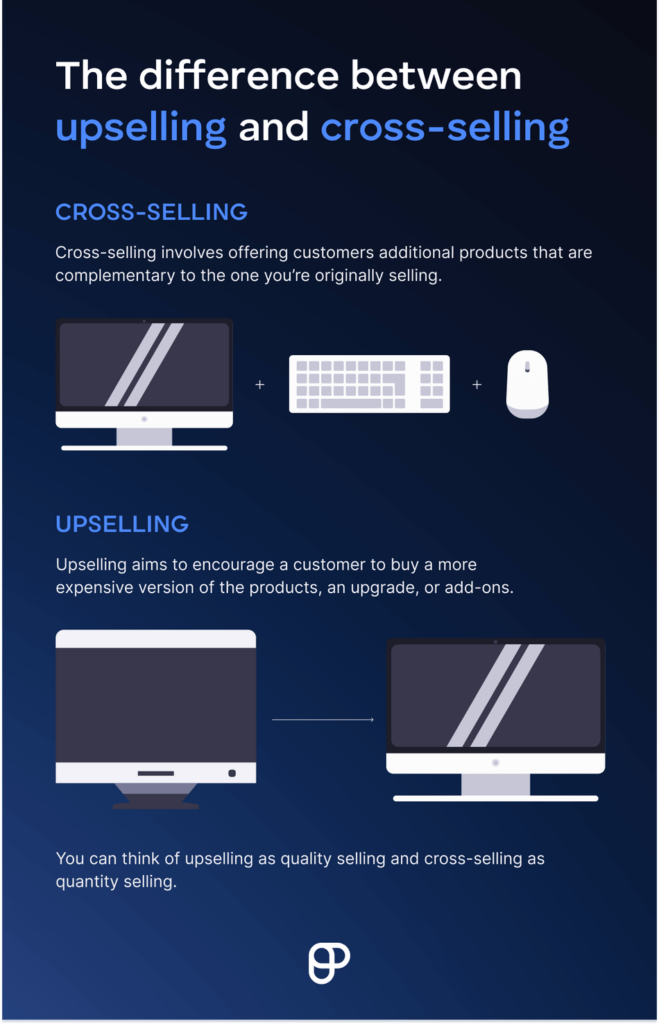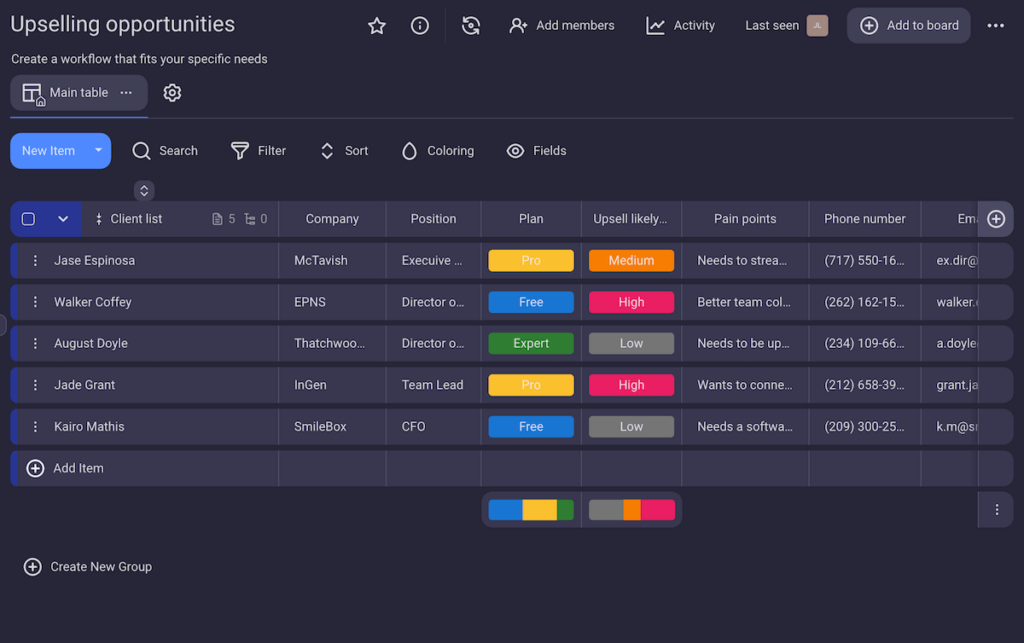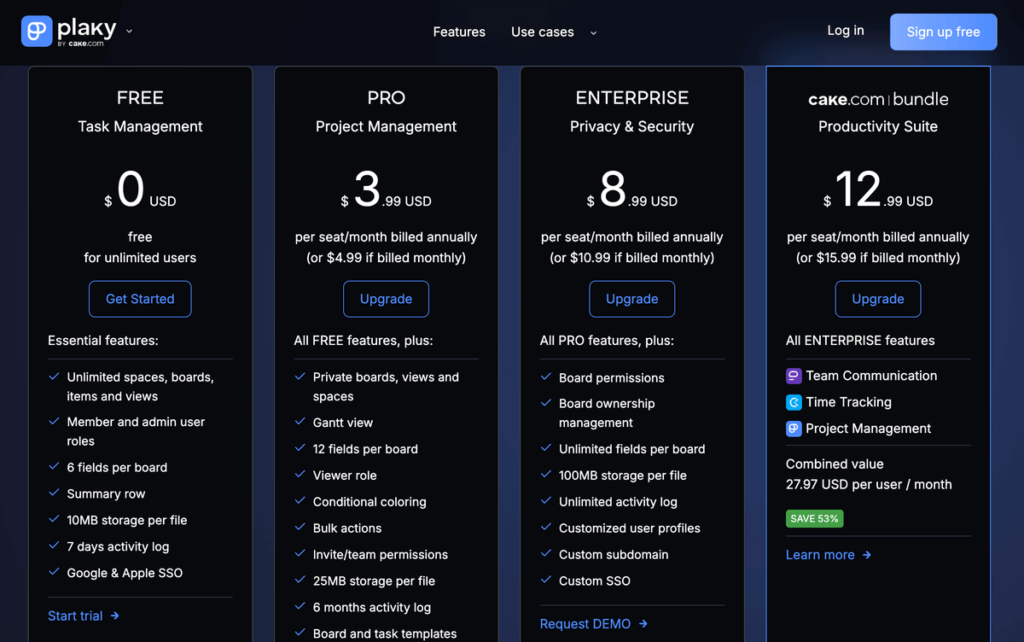When a customer comes into your store, do you just help them find what they’re looking for, or do you help them find what they actually need?
Getting to know your customers is a key part of sales — it not only improves your customer relations but also helps your sales team learn about the customers’ pain points.
The thing is, customers usually settle for “good enough and cheaper,” even if this means they won’t get the best product for their needs.
The key is in selling a product or service that solves their problem, even if it’s a more costly solution. That is the goal of upselling.
While it benefits both you and the customer, the advantages of upselling might not always seem obvious to the customer — so you need to use this technique carefully.
That said, let’s dive into what upselling is and how you can use it to boost your sales.

In this article:
What is upselling?
Upselling is a sales technique that involves trying to make a better sale by offering a higher-end, upgraded version of a product or service. It’s one of the best techniques you can use to directly increase your sales revenue.
Upselling requires you to:
- Get to know your customer,
- Understand their needs and pain points better, and
- Suggest an upgraded product or an add-on that can help alleviate those pain points.
For example, when selling a phone, you might suggest one that has a higher quality camera or better storage — because that’s what your customer might need and you want to make them happy.
Obviously, this also means that upselling is extra work. So — does that make it good or bad?
In reality, upselling is almost never harmful to your business. If you just explore your opportunities and time your upselling efforts well, you won’t have to worry about that extra work.

The major benefits of upselling include:
- Increasing sales revenue — When you upsell, you always sell at a higher price, which means more profits. But, you can also upsell to past clients and get more sales on the existing customer base.
- Boosting customer retention—If your upsell is successful, you’ll have a satisfied customer — and a satisfied customer easily becomes a recurring one. To achieve this, your communication skills need to be on point.
- Improving your company’s reputation and brand awareness — Customer satisfaction also improves your brand’s reputation. Whether it’s from word-of-mouth or an online review, a happy customer will always bring in more.
What is the difference between upselling and cross-selling?
Cross-selling involves offering customers additional products that are complementary to the one you’re originally selling.
Upselling refers to trying to make a better sale by selling a higher quality version of the product, while cross-selling means selling multiple products.
You can think of upselling as quality selling and cross-selling as quantity selling.
For example, a salesperson using upselling might suggest a better-quality washing machine with an integrated dryer.
On the other hand, a cross-selling salesperson might recommend a more affordable washing machine, and then offer a drying machine on top of that.

Upselling examples
Upselling is great for your business, but not everything can be sold using this technique. So, we’ve gathered some examples of the most appropriate products to upsell.
Example #1: Technology
Almost anything that involves technology is easy to upsell — phones, laptops, PCs, TVs, and even appliances like dishwashers and washing machines all fall under this category.
Tech products have a wide range of features, so you have a lot of room to zoom in on specific pain points. Most come in many versions focused on specific features as well — for example, a work laptop vs. a gaming laptop.
While interacting with the customer, you want to determine which feature(s) you can focus on and try to sell an upgraded version of the product accordingly.
Some technology upsells would be:
- A phone service provider offering a better phone when a client is renewing their contract,
- Offering a higher-end camera to a film studio, with a higher shutter speed for fast-paced scenes, and
- Offering an architecture student a higher-end laptop that can handle rendering more efficiently.
Example #2: Service industries
Upselling is very common in the service industry and can be easily spotted in:
- Restaurants,
- Hotels,
- Airlines,
- Spas,
- Cinemas, etc.
Some of the upselling opportunities in service industries include:
- A hotel offering a better room for a similar price or added services with the room for a minor increase in price,
- Airlines offering a higher-class ticket with more comfortable seating, or
- A restaurant offering the week’s special to a customer, when they’ve been thinking about a cheaper meal with the same protein.
Example #3: Software
Like physical tech products, software comes with many features to focus on when upselling.
However, software has a significant advantage over physical products. For instance, it can have a free version. This option shows people what they can expect from a product while leaving room for upgrading to the features hidden behind a paywall.
Once the customer notices they would benefit from a paid feature, upselling will go extremely smoothly.
Software upselling opportunities include:
- A video subscription service offering higher-quality videos in higher-paid plans,
- Any software company offering a premium plan to get rid of ads in its app, and
- A cloud-based software company offering more storage space with its premium plans.
Additional upselling examples
Some examples of upselling outside of these 3 categories could be:
- Car dealerships offering a higher-quality vehicle that uses less gas and is more eco-friendly,
- A real estate agent offering a better apartment in the client’s desired neighborhood as a larger unit would be better for a family,
- An optics store offering prescription glasses with blue light filters instead of the regular ones with no filter, and
- A furniture upholstering service offering higher-quality materials to their customers, listing comfort or easier maintenance as reasons for the upgrade.
💡 Plaky Pro Tip
If you want to learn more about sales and its importance, check out this helpful article for sales project managers:
4 steps to successful upselling
When upselling, you don’t want to jump straight into promoting the higher-quality product — that might actually push the customer away.
Instead, you need to be careful with your approach by dividing your upsell into 4 steps:
- Focus on the original purchase,
- Find a good upsell,
- Introduce the upsell, and
- Follow up after the sale.
Step #1: Focus on the original purchase
If you want to upsell, you need a customer who wants to buy something lower-quality first. So, the first step of upselling is to actually give the customer what they originally intended to buy.
This is the perfect time to focus on your customer’s needs — find pain points that they’re trying to resolve with the product. You may want to ask yourself:
- Why do they need this product?
- What results are they expecting from it?
The answers can range from something small — like wanting a good phone camera — to something more serious — like needing new software for their company.
From here on, you’ll know what to focus on when upselling.
Step #2: Find a good upsell
Now that you’re aware of your customer’s needs, you’re ready to find a better alternative for them.
Ideally, you’ll find an alternative that improves the quality of the initial product exactly where the customer needs it — but that’s less likely.
Instead, focus on finding a solution that improves on what they need and changes as little as possible where they don’t need it.
Familiarity is important to customers, so if you suggest an upgrade that varies too much from the original buy, they’re less likely to accept it.
This is also the step where you decide whether you want to upsell or cross-sell.
There are 3 major indicators of this decision:
- What’s in your inventory — If you don’t have any complementary items in your store, you can’t cross-sell. Think carefully about what you can offer to your customers.
- What brings the largest profit — If selling a better-quality PC brings a larger profit than trying to cross-sell more RAM to go with the initial PC, go for the upsell when appropriate.
- What the customer needs — Most importantly, learn from your customer’s wishes. Analyze their needs, and you’ll know what decision is best.
Track your inventory with Plaky
Step #3: Introduce the upsell
In this step, you want to pitch a higher-quality product to your customer.
Again, the information from the previous step will be crucial here. Reference your conversations and explain why this product is more useful to them than the one they originally planned on buying.
For example, imagine that you’re selling a PC to a customer who wants to play plenty of video games. During the conversation, you’ve concluded that ample storage and a good graphics card are what you should focus on.
When pitching this upsell, introduce the customer to the idea that less than a year from now, they might need to buy additional storage or a better graphics card to accommodate their needs.
Instead of spending more money over an extended period, wouldn’t it be better to just get a higher-quality product now as a long-term investment?
If your communication with the customer flows successfully, by this point, you’ve earned their trust. So, if you suggest a change, they will be more likely to consider it.
💡 Plaky Pro Tip
Just like upselling is a delicate process, so is deciding on how to price your products. Check out this article on the best pricing strategies:
Step #4: Follow up after the sale
Following up is crucial to a successful sale, as it showcases client loyalty and further personalizes the interaction.
It’s important that every customer feels appreciated and seen. To achieve this, you need to make sure not to cut contact as soon as you get their money.
Follow up with your customer to see if they’re satisfied with their product, or if they’re having any difficulties you could help with. This goes a long way to increasing customer retention and boosting your reputation.

6 expert upselling tips, tricks, and tactics
Upselling can be tricky to navigate, and if it goes wrong, a salesperson may come across as pushy.
To help you approach it correctly, we’ve decided to gather some expert tips on how to improve your upselling technique.
Tip #1: Personalize
Many sales strategies include personalization as an effective way of selling your product, but upselling depends on it.
We spoke with Jon Morgan, a CEO of a leading consulting firm with over 9 years of consulting experience, on this topic, and he believes you should make every sale specific to the customer:

“Tailoring your upsell offers to each customer’s specific needs and preferences is crucial. Utilize customer data and purchase history to recommend relevant products or services. By demonstrating that you understand their unique requirements, you increase the likelihood of a successful upsell.”
If you want the customer to buy the upsell, you need to understand what they want.
Otherwise, if you try to offer them something they neither want nor need, you have no chance of making a successful sale — but you increase your chances of aggravating them.
💡 Plaky Pro Tip
If you want to improve your customer relationship management, you might want to consider using a CRM template to help you track customer interactions:
Tip #2: Provide social proof
Before buying, customers have a tendency to check reviews of that product or service first. After all, when you decide to commit to something, you want to feel like you’re making the right decision.
Jon explains how you can help the customers out in this process:

“Share customer reviews and success stories related to your upsell options. When potential buyers see that others have benefited from the upsell, it builds trust and confidence in their decision to upgrade.”
The reputation of your product or service matters. So, you want to pay attention to it and always bring its benefits to the spotlight.
Tip #3: Highlight the value it could bring them
Have you ever seen a commercial for a new phone where they listed feature after feature after feature, and thought to yourself — why would I even need this?
Well, your customers will more often than not think this way. We spoke to Frank Sondors, a SaaS founder with a mission to revolutionize sales, who explained why it’s important to highlight the upsell’s value:

“The key to a successful upsell is making it relevant by adding value. Customers don’t want to feel like they’re being sold to — they want to feel like the offer genuinely enhances what they’re already getting.
One trick I’ve seen work well is tying the upsell to a specific problem the customer has. For example, we worked with a SaaS company that introduced an AI-powered analytics add-on to their base subscription. Instead of pitching it as “extra,” the sales team framed it as a way to save time analyzing data manually. This approach boosted upsell rates by 20%.”
Basically, focus more on the why than the what.
Using the example of selling a washing machine with dryer capabilities, you may want to explain how having a 2-in-1 appliance saves space in your home. Alternatively, you can emphasize the fact that air drying becomes difficult in the winter months.
Tip #4: Help your customers get used to the product
A more high-end product usually means more features and capabilities. Many customers might be intimidated by all these features and wish to stay within the comfort zone of what they know, refusing the upsell.
To tackle this issue, Jon suggests you encourage customers to learn about the new product:

“Offer training and support resources for the upsell. If customers feel they will receive adequate assistance in implementing or using the additional product or service, they are more likely to commit to the upsell.”
Once you reassure them by offering help and assistance, the upsell won’t seem as scary, allowing the customer to continue with the buying process with less stress.

Tip #5: Maintain communication with customers
Customers like to feel appreciated — which is why good customer service is the pillar of every business. So, you want to make sure they know you weren’t just going to take their money and disappear. Jon explains how to follow up:

“After the initial purchase, maintain communication with the customer. Send targeted emails or notifications about relevant upsell opportunities, especially when new features or products are introduced.”
Let’s say, a couple of weeks ago, you successfully sold a paid plan for photo editing software. You tried talking the client into upgrading to a higher-tier plan, but they don’t need any of the features that it offers.
Since then, your company has rolled out new features on the higher-tier plan. So, you contact the client again, and — the new features are just what they were missing. They decide to upgrade, and your upsell is successful.
On the other hand, if there’s a separate product or service that has been rolled out, and it could be complementary to something you sold — it’s a good opportunity to cross-sell.
This is why maintaining communication with existing customers is so important.
Tip #6: Time your upsell
Deciding what time is appropriate to upsell is a must — poor timing can close the door on that sale forever.
According to Frank, the best time to upsell is when the customer knows the value of both products:

“Timing is everything. Upselling works best after the customer has experienced value from the initial purchase, not at the moment of sale. Train your team to listen for opportunities in conversations, such as when a customer mentions a challenge your additional offering could solve. It’s about meeting needs, not hard-selling products.”
If the customer knows the value they can get from your original product, your upsell just builds on that value.
Of course, this comes easier with subscription-based software, where you can delay the upsell until your customer learns the value — and the limitations — of a lower-tier subscription.
Still, you can highlight value with any type of product, e.g., by having test products available in the store or by improving your conversational skills.

Keep track of your upselling opportunities with Plaky
As mentioned throughout this article, a big part of upselling is knowing your client.
But, when you’re dealing with lots of clients, all with personal info that you need to remember — how do you even keep track of all of them?
For this, we’d recommend our project management software, Plaky.
In Plaky, you can create a customized board to track customer info that’s necessary for your sales team.
Let’s say you’ve got a software company — selling a video editing app. There are many things you need to track about your clients, e.g.:
- Name,
- Company,
- Position,
- Phone number,
- Email, and
- Pain points.
You can store all of this info in a single board even if you sign up for Plaky’s free plan — which offers unlimited boards, tasks, users, and up to 6 custom fields. Just enough!

No more scribbling client info on random pieces of paper, then realizing you accidentally threw them away because you last talked to the client weeks ago. Instead, you can have your client information neatly organized in Plaky and available at all times to your whole team.
Information needs to be shared with your team in sales — everyone learns from each other’s successes and failures. So now that you have pain points in one place, if you get a new paid plan feature that helps a certain pain point, anyone can:
- Contact one of your current free plan clients,
- Catch up easily, and
- Upsell them to a paid plan.
And yes, if you need to store more client info — like how they came into contact with the sales team, or how likely they were to accept an upsell — you can check out one of Plaky’s paid plans.

Need someone to keep track of your clients while you do the heavy lifting? Say no more. Sign up for a free Plaky account today.

